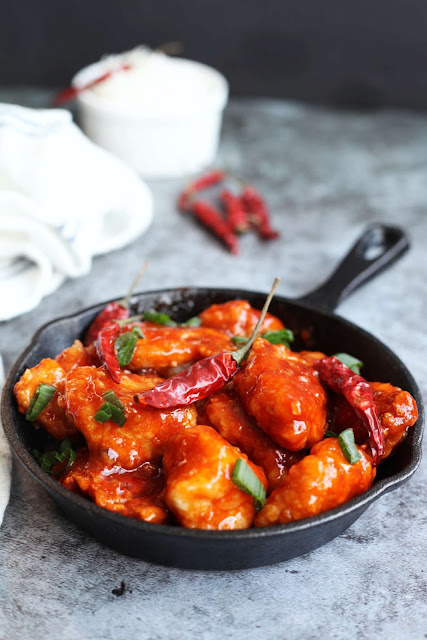Sichuan chicken is an iconic dish of the Sichuan province cuisine. It consists of pieces of fried chicken that are sautéed in a slightly sweet, spicy sauce flavored with Sichuan pepper, green onions, garlic and dried red chilies. Usually is served with green onion strips and fresh coriander.
For the chicken
- 12 oz. chicken fillet , cut into large 1 inch (2,5 cm) dice
- 2 egg whites
- ½ teaspoon salt
- ¼ teaspoon crushed Sichuan pepper
- 2 teaspoons soy sauce
- 4 tablespoons cornstarch
- Vegetable oil , for frying
For the sauce
- 4 dried red peppers , cut into strips
- 1 teaspoon freshly ground Szechuan pepper
- 2 cloves garlic , chopped
- 1 tablespoon chopped fresh ginger
- 4 scallions , greens and whites separated
- 2 tablespoons soy sauce
- 1 tablespoon rice vinegar
- 1 tablespoon shaoxing wine
- 2 tablespoons red pepper paste
- 2 teaspoons brown sugar
- ½ teaspoon salt , adjust to taste
- ½ teaspoon ground white pepper
- 1 small bunch fresh cilantro , chopped
Chicken
In a bowl, add the chicken, salt, pepper, soy sauce and cornstarch.
Add the egg white and mix everything well until the chicken is coated.
Heat an oil bath in a pan over medium heat.
When the oil is moderately hot, delicately immerse the chicken pieces one after the other.
Fry them over medium to high heat until golden brown and crispy.
Drain, keeping 2 tablespoons of frying oil in the pan and reserve the chicken.
Chicken in sauce
In the hot oil, add the dried red peppers and sauté for 1 minute over low to medium heat.
Add the garlic, red pepper paste and ginger and brown them over high heat for 30 seconds.
Then add the scallion whites and sauté for 1 minute.
Add the ground Sichuan peppercorns and sauté for 30 seconds.
Then add the soy sauce, shaoxing wine, sugar, vinegar and very little salt.
Mix well.
Pour in 4 tablespoons of water and let the sauce bubble and thicken slightly.
Taste the sauce and add more chili paste, Sichuan pepper, sugar, salt, or vinegar, to taste.
Stir in the fried chicken and stir over high heat for 1 minute until the sichuan sauce coats the chicken well.
Sprinkle with ground white pepper and the green of the scallions.
Garnish the Szechuan chicken with fresh cilantro leaves.
Serve hot with noodles or fried rice.




